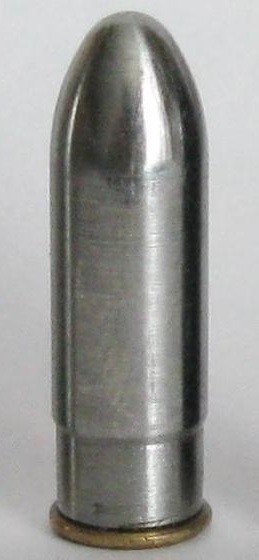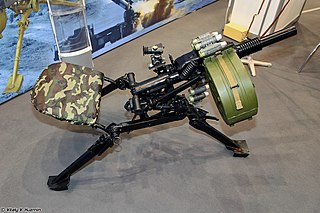
A revolver is a repeating handgun that has at least one barrel and uses a revolving cylinder containing multiple chambers for firing. Because most revolver models hold up to six cartridges, before needing to be reloaded, revolvers are commonly called six shooters or sixguns. Due to their rotating cylinder mechanism, they may also be called wheel guns.

A grenade launcher is a weapon that fires a specially designed, large-caliber projectile, often with an explosive, smoke, or gas warhead. Today, the term generally refers to a class of dedicated firearms firing unitary grenade cartridges. The most common type are man-portable, shoulder-fired weapons issued to individuals, although larger crew-served launchers are issued at higher levels of organization by military forces.

Caseless ammunition (CL), or caseless cartridge, is a configuration of weapon-cartridge that eliminates the cartridge case that typically holds the primer, propellant and projectile together as a unit. Instead, the propellant and primer are fitted to the projectile in another way so that a cartridge case is not needed, for example inside or outside the projectile depending on configuration.

The FN F2000 is a 5.56×45mm NATO bullpup rifle, designed by FN Herstal in Belgium. Its compact bullpup design includes a telescopic sight, a non-adjustable fixed notch and front blade secondary sight. The weapon has fully ambidextrous controls, allowed by a unique ejection system, ejecting spent cartridge casings forward and to the right side of the weapon, through a tube running above the barrel. The F2000 made its debut in March 2001 at the IDEX defence exhibition held in Abu Dhabi, in the United Arab Emirates.

The GP-25 Kostyor ("Bonfire"), GP-30 Obuvka ("Shoe") and GP-34 are a family of Russian 40 mm under-barrel muzzleloaded grenade launchers for the AK family of assault rifles. The acronym GP stands for Granatomyot Podstvolnyj, "grenade launcher" in Russian, and was adopted by Soviet forces in 1978. They were first seen by the West in 1984, during the Soviet invasion of Afghanistan.

The K100 is a 9×19mm semi-automatic pistol designed and built by Grand Power s.r.o. in Slovenská Ľupča, Slovakia located approximately 11 kilometers east of Banská Bystrica, Slovakia which is the region's major city.
The Advanced Individual Combat Weapon (AICW) was an Australian prototype combination assault rifle and grenade launcher developed as a technology demonstrator. The AICW combined a standard 5.56 mm assault rifle based on the successful F88 Austeyr with a superposed load grenade launcher developed by Metal Storm.

The OTs-14-4 "Groza-4" is a Russian selective fire bullpup assault rifle chambered for the 9×39mm subsonic cartridge. It was developed in the 1990s at the TsKIB SOO in Tula, Russia.

The HK69A1 is a 40 mm grenade launcher developed and produced by the German arms manufacturer Heckler & Koch (H&K). The weapon was designed to engage enemy troops and strongpoints out to a distance of 350 m; it can also be used to deploy smoke grenades and illumination flares.
The SG 550 is an assault rifle manufactured by SIG Sauer AG in Switzerland. "SG" is an abbreviation for Sturmgewehr. The rifle is based on the earlier 5.56×45mm NATO SIG SG 540.
The MM-1 is a 40x46mm semi-automatic grenade launcher manufactured during the 1980s in the United States by the Hawk Engineering Company. Relatively heavy and bulky, the MM-1 can provide considerable firepower, with practical rate of fire as high as 30 rounds per minute. It can be useful in ambushes and other fast-paced close combat situations.

In firearms, the cylinder is the cylindrical, rotating part of a revolver containing multiple chambers, each of which is capable of holding a single cartridge. The cylinder rotates (revolves) around a central axis in the revolver's action to sequentially align each individual chamber with the barrel bore for repeated firing. Each time the gun is cocked, the cylinder indexes by one chamber. Serving the same function as a rotary magazine, the cylinder stores ammunitions within the revolver and allows it to fire multiple times before needing to reload.

The Ruger Vaquero is a six-shot single-action revolver manufactured by Sturm, Ruger & Co. based on the New Model Ruger Blackhawk frame and was introduced in 1993. It comes in blued steel, case colored, and a gloss stainless finish, all of which are available with wood, hard rubber, simulated ivory or black micarta grips and fixed sights. It arose with the popularity of Cowboy Action Shooting from which came demand for a single-action revolver that was more traditional in appearance.
The Manville gun was a stockless, semi-automatic, revolver type gun, introduced in 1935 by Charles J. Manville. The Manville Gun was a large weapon, with a heavy cylinder being rotated for each shot by a clockwork-type spring. The spring was wound manually during the reloading.

The Milkor MGL is a lightweight 40 mm six-shot revolver-type grenade launcher developed and manufactured in South Africa by Milkor (Pty) Ltd. The MGL was demonstrated as a concept to the South African Defence Force (SADF) in 1981. The MGL was then officially accepted into service with the SADF as the Y2. After its introduction in 1983, the MGL was gradually adopted by the armed forces and law enforcement organizations of over 50 countries. Total production since 1983 has been more than 50,000 units.
The 40 mm Under Barrel Grenade Launcher, is a single shot grenade launcher developed by ARDE and Ordnance Factory Tiruchirappalli for use with the INSAS and AK-47 rifles used by the Indian Army. Stand alone versions of the grenade launcher exist.

The RGP-40 is Polish six-shot revolver-type 40 mm grenade launcher designed by WAT and OBR SM Tarnów and produced by ZM Tarnów. Its design is heavily influenced by the M32 MGL.

AGS‑40 Balkan is a Russian 40 mm caseless automatic grenade launcher and successor to AGS-17 and AGS-30, introduced and adopted by the Russian military.
The QLG-10 and QLG-10A are a family of Chinese 35 mm under-barrel grenade launchers designed for QBZ-95 and QBZ-95-1 of assault rifles. The launcher fires 35mm caseless grenades, designated DFS-10.












